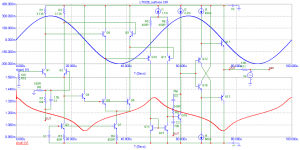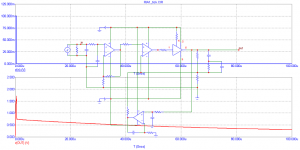Scott, this is a phono stage, with RIAA EQ. This makes the problem significantly worse, because the RIAA curve essentially INTEGRATES the noise curve. You obviously need to get some real measurements under your belt regarding these devices.
Of course, we don't easily hear noise below 100 Hz, but we still have to keep it under reasonable control.
Of course, we don't easily hear noise below 100 Hz, but we still have to keep it under reasonable control.
No I am not, PMA, but this problem looks obvious to me. Maybe an 811 buffer or its equivalent, will be necessary to keep the higher order distortion generation to a minimum.
As I said before,
I rate component quality/type as the most important part when making an amplifier. Incl PCB material with its laquer and trace metall, wiring, GND schemes, vibration issues, connectors.
My last PCB is made out of ceramics.
Simulation is only a tool to create a design. And a darn good too it is, too. I do not want to be without a simulator. I have done years and years of breadbording and with the simulator, I can get a design working faster on the bench.
I hope I do not give the impression that "bedroom armchair theoretical argueing" is my goal. It is not. My goal is to make designs that sound as good as the Lyra Connosieur amplifiers, ie the creme de la creme, the ne plus ultra amongs amplifiers (and also DACs and loudspeakers).
Sigurd
I rate component quality/type as the most important part when making an amplifier. Incl PCB material with its laquer and trace metall, wiring, GND schemes, vibration issues, connectors.
My last PCB is made out of ceramics.
Simulation is only a tool to create a design. And a darn good too it is, too. I do not want to be without a simulator. I have done years and years of breadbording and with the simulator, I can get a design working faster on the bench.
I hope I do not give the impression that "bedroom armchair theoretical argueing" is my goal. It is not. My goal is to make designs that sound as good as the Lyra Connosieur amplifiers, ie the creme de la creme, the ne plus ultra amongs amplifiers (and also DACs and loudspeakers).
Sigurd
PMA said:
The answer is IMO easy. Many people just do not care. They are not interested in actual real world results, not interested in listening tests, not interested in direct comparisons. Bedroom armchair theoretical argueing, that is the goal.
john curl said:...an 811 buffer..
...Is the one I use in my professional instruments (2 in parallel).
The problem is obvious to me as well, as I answered syn08 in his GPP thread recently.
Sigrurd, I certainly see you doing good work, but I addressed these problems long ago, without a computer, and I am starting to see oversights in the design process, and excessive reliance on computer models. I am not against computer simulation, I have used it myself for the last 43 years.
PMA said:You're right as always, John :
Either you and John never read my AES paper or you didn't understand it. It has pictures too showing removal of crossover "bump" same bump as you show here on "other" guys part. Bruce Hofer of AP understood.
We actually gain some performance by having a RIAA network, don't we?
E.g a 10 Ohm resistor has a total noise 20-20k of 57n,
but adding a RIAA curve gives a total noise of 39n (all at 27 deg C).
Sigurd
E.g a 10 Ohm resistor has a total noise 20-20k of 57n,
but adding a RIAA curve gives a total noise of 39n (all at 27 deg C).
Sigurd
john curl said:Scott, this is a phono stage, with RIAA EQ. This makes the problem significantly worse, because the RIAA curve essentially INTEGRATES the noise curve. You obviously need to get some real measurements under your belt regarding these devices.
Of course, we don't easily hear noise below 100 Hz, but we still have to keep it under reasonable control.
scott wurcer said:
Either you and John never read my AES paper or you didn't understand it. It has pictures too showing removal of crossover "bump" same bump as you show here on "other" guys part. Bruce Hofer of AP understood.
I respectfully admit I haven't.
Thanks!
I must agree with you that a design that works in the simulator, will need addition of many componentes to get a working amplifier. For ex decoupling, input filters, protection circuitry etc etc. I know all that.
PCB layout is an art in itself.
Manufacturing issues can be overwelming and always creates issues to deal with.
Then one needs to be able to measure the amplifiers' noise performance which is not that easy, either.
Sigurd
I must agree with you that a design that works in the simulator, will need addition of many componentes to get a working amplifier. For ex decoupling, input filters, protection circuitry etc etc. I know all that.
PCB layout is an art in itself.
Manufacturing issues can be overwelming and always creates issues to deal with.
Then one needs to be able to measure the amplifiers' noise performance which is not that easy, either.
Sigurd
john curl said:Sigrurd, I certainly see you doing good work, but I addressed these problems long ago, without a computer, and I am starting to see oversights in the design process, and excessive reliance on computer models. I am not against computer simulation, I have used it myself for the last 43 years.
I do have 2 pcs of AD797 in my bookshelf, maybe sometimes I may try, as I do not have any reliable AD797 computer model (or Scott would e-mail me a real-part schematics 😀 )
Silly question of the day:
What happens to the AD797 when the phone cartridge encounters a "tick" (no, not the kind of insect that causes Lyme disease) on a record? The load impedance on the output is only a few Ohms at 10 KHz, if I read the schematic right.
What happens to the AD797 when the phone cartridge encounters a "tick" (no, not the kind of insect that causes Lyme disease) on a record? The load impedance on the output is only a few Ohms at 10 KHz, if I read the schematic right.
0.5mV input signal, 64dB gain
The feedback network values are in kOhm, not Ohms,
otherwise you wouldn't get 64dB of gain
It is so surprising ... it can be done with a calculator, easily enough, or even pencil and paper. 😀
- Status
- Not open for further replies.
- Home
- Amplifiers
- Solid State
- John Curl's Blowtorch preamplifier


